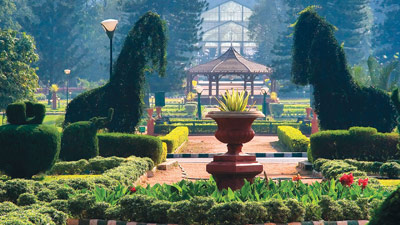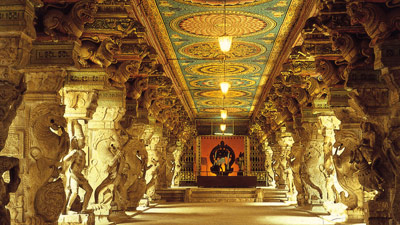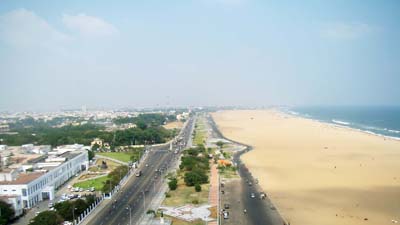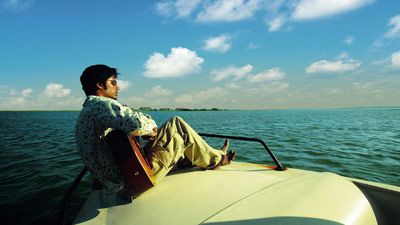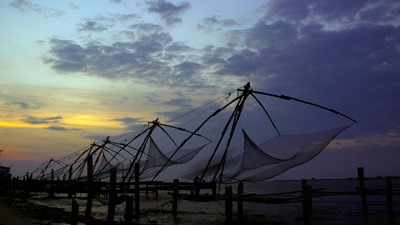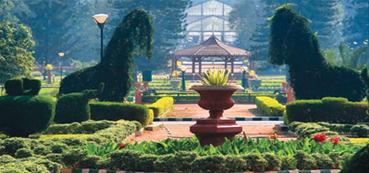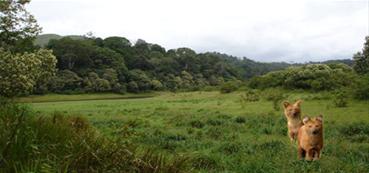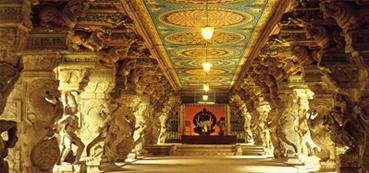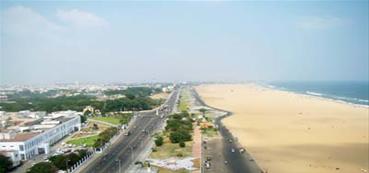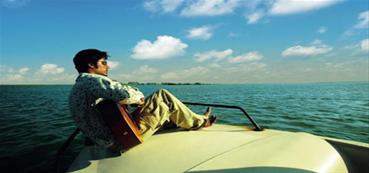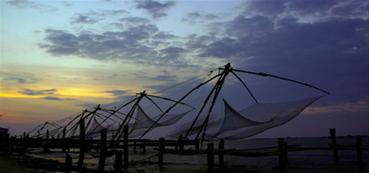You May Also Like
Your tour begins from Chennai, from where you proceed to visit the temples of Mahabalipuram and Kanchipuram. Before entering Thekkady district of Kerala, you will visit a number of temples at Trichy and Madurai town of Tamil Nadu. Periyar Wildlife Sanctuary is home to a variety of wild animals that include tigers, elephants, leopards, wild dogs, langur monkeys’ etc.
Next head towards port city of Cochin which is home to a number of attractions like Jewish Synagogue, Portuguese Churches and Dutch Palace. After exploring the city of Cochin head towards Karnataka's famous city Mysore and end your tour at India’s IT Capital- Bangalore.
Destinations & Night Stays
Highlights of South India
Arrival at Chennai and transfer to the hotel.
Afternoon, city tour of Chennai hailed to be the liveliest city in entire South India. The city has its own unique charm, which sets it aside from the rest of the big cities. The vibrancy of rich culture and traditions exuded by the city and its residents is simply moving. It is one such city in Tamil Nadu, which has been blessed with an extreme treasure of tourist attractions. The tour includes beautifully carved temples, serene beaches, colonial monuments and much more. So, come and explore the magnificent city of Chennai, rightly called the 'Gateway to South India'.
Overnight at the hotel.
Leave for Pondicherry by car.
En-route visiting Kancheepuram and Mahabalipuram.
Kanchipuram - the `Golden City’ was once the capital of the Pallavas and the Cholas. These two powerful ruling dynasties gave the city its numerous temples and tanks. The city is also famous for its Kancheepuram Silk’. It has still has 150 active temples, dedicated various gods and goddesses.
Kancheepuram is also one of 7 holy cities in India. In Kanchipuram visit the Kailashnath Temple, one of the oldest temples, built in the 7th century AD. It is built of sand stone and houses some of the most elegant sculptures of Natraja (Shiva in cosmic dance).
Later, visit Ekambareshwara-Temple, the biggest in the city, are large complexes with mandapas, tanks and sculptured halls with devotees who still flock here. It has an ancient mango tree, and it’s believed that its branches represent the four Vedas and its fruits are said to have a different taste. (Non Hindus are not allowed inside the main sanctum)
Continue your drive to Mahabalipuram.
Mahabalipuram - Visit the magnificent rock temples and carvings in Mahabalipuram. Five Rathas (chariots) ceremonial chariots, rock-cut monoliths, named after the 5 Pandavas - heroes of the Mahabharata epic and Draupadi their wife. The Shore Temple by the sea surrounded by gardens designed according to descriptions of the original layout from ancient times. Built in sandstone in the 7th century. Bhagiratha’s Penance is a bas- relief (27 to 9m) sculptured on the face of two enormous adjacent rocks, depicts, the penance of Arjuna, myriad characters from the Mahabharata (a Hindu epic) with realistic life-size figures of animals, gods and saints depicting the descent of the river goddess Ganga to earth.
Continue drive to Pondicherry.
Pondicherry - The last French settlement in India till 1954. Despite its invigorating seafront and relaxing atmosphere the town is visited above all for the Sri Aurobindo Ashram which draws visitors from all over the world.
Check-in at hotel.
Overnight at the hotel.
Short city tour of Pondicherry include Aurobindo Ashran, before departing for Tanjore by Car.
The Ashram, which was, founded by Sri Aurobindo a onetime Bengal evolutionary who later took to the spiritual pat & Auroville, the city of Dawn was started in Feb. 1968 as a unique experiment in international living, where people live and work in total harmony.
The Sri Aurobindo Ashram located on rue de la Marine, is one of the most well known and wealthiest ashrams in India, with devotees from India and all over the world flocking to it for spiritual salvation. Its spiritual tenets represent a synthesis of yoga and modern science. Children below 3 years of age are not allowed into the ashram and photography is allowed only with permission of the ashram authorities.
Continue your drive to Tanjore.
En-route visit Chidambram and Swamimalai.
Chidambaram is also known as Thillai, since the place was originally a forest of the thillai, botanically known as excecaria agallecha shrubs. It is an important pilgrim centre and a holy place for Saivites as the famous Nataraja Temple is located here.
Dedicated to Lord Nataraja, this ancient temple of the Cholas is unique not only it is devoted solely to the art of Bharatanatyam, but also it is one of the rare temples where Shiva is represented by an idol rather than the customary lingam. Spread over an area of 40 acres with a gopuram on each side, the temple is distinguished by five sabhas or courts.
Arrive in Tanjore in the late afternoon
Tanjore rose to glory during the later Chola period between the 9th and 14th centuries A.D. It also flourished later during the rule of the Nayaks and Mahrattas. It has been the treasure house of art for centuries and is also called the Rice Bowl of Tamil Nadu. Thanjavur is well-known throughout the world for being the home of the Brahadeeswara temple, the magnificent Palace, Rajah Serfoji's Saraswathi Mahal Library, Art Gallery and also for its exquisite handicrafts like the Art Plate, pithwork, bronze icons, Thanjavur paintings and the classical South Indian musical instruments.
Transfer to the hotel
Overnight at the hotel.
Trichy: City tour of trichy visit the Rock Fort, Srirangam, one of the largest temple of God Vishnu; and the Jamkeswaram Temple of Lord Shiva submerged in water.
Srirangam Temple : The temple occupies an area of 156 acres (6,31,000 m²) with a perimeter of 1,116m (10,710 feet) making it the largest temple in India and one of the largest religious complexes in the world. In fact, Srirangam temple can be easily termed as the largest functioning Hindu temple in the world. The temple is enclosed by 7 concentric walls with a total length of 32,592 feet or over six miles. These walls are enclosed by 21 Gopurams (Towers). Among the marvels of the temple is a "hall of 1000 pillars" (actually 953). Return to Tanjore
In the afternoon and visit the Brihadishwara temple - A 107 paragraph long inscription on the walls of the Vimanam records the contributions of Raja Raja Chola and his sister Kundavai to the Thanjavur temple. The temple stands within a fort, whose walls are later additions built in the 16th century. The towering vimanam is about 200 feet in height and is referred to as Dakshina Meru. The octogonal Shikharam rests on a single block of granite weighing 81 tons. It is believed that this block was carried up a specially built ramp built from a site 6 kilometeres away from here. Huge Nandis dot the corners of the Shikharam, and the Kalasam on top by itself is about 3.8 meteres in height. Hundreds of stucco figures bejewel the Vimanam, although it is possible that some of these may have been added on during the Maratha period. The Shivalingam - Peruvudaiyar, Rajarajeswaramudaiyar - is a huge one, set in a two storied sanctum, and the walls surrounding the sanctum delight visitors as a storehouse of murals and sculpture.
Overnight at the hotel.
Belur & Halebid
: This quaint hamlet –BELUR - 38 kms from Hassan - is located on the banks of the river Yagachi. It was once capital of the Hoysala Empire today made unforgettable for its exquisite temples. The Shennakeshava is one of the finest examples of Hoysala architecture. It took 103 years to complete this architectural marvel. The facade of the temple is filled with intricate and frescos, with no portion left blank. Elephants, episodes from the epics, sensuous dancers. They are all there - awe-inspiring in their intricate workmanship. Hand-lathe-turned filigreed pillars support the temple. The Veeranarayana Temple and the smaller shrines are worth a visit. Halebid - Halebid is 27 kms northwest of Hassan and 17 kms east of Belur. The temples of Halebid - like those of Belur - bear mute testimony to the rich, cultural heritage of Karnataka. The Hoysaleswara Temple, dating back to the 21th century, is astounding for its wealth of sculpture details. The walls of the temple are covered with an endless variety of Gods. Overnight at hotel
Route Map
Plan your own trip
| Hotels | Period | Type | Price (Starts From) |
|---|---|---|---|
|
3 Star
|
Apr / Sep'25 | Private | $1695.00 |
|
3 Star
|
Oct'25 / Mar'26 | Private | $2110.00 |
|
4 Star
|
Apr / Sep'25 | Private | $1850.00 |
|
4 Star
|
Oct'25 / Mar'26 | Private | $2335.00 |
| Send Inquiry | |||
Notes
- This Tour Includes 14 nights accommodation with Breakfast in India
- Prices are Per Person on Twin Sharing Basis
- Prices are based on 02 persons traveling together by Private Chauffer Driven Air-conditioned Car
- Prices include the services of an English Speaking guide for all sight seeing and Single entrance fee to all monuments mentioned in the itinerary.
- Prices are not valid during Christmas & New Year period
- Tour can be customized as per your requirement
- Hotels mentioned above or similar will be provided
- Terms & Conditions apply. Please contact us for full details.


